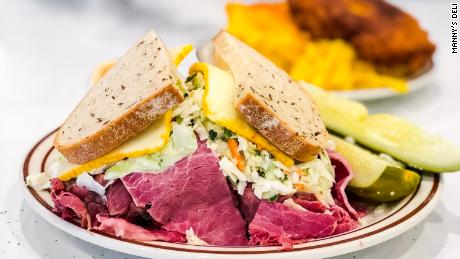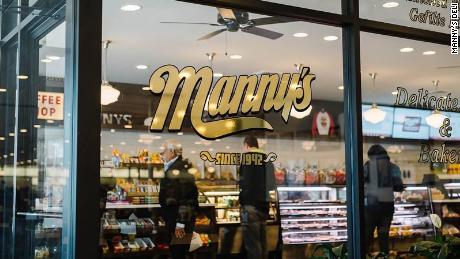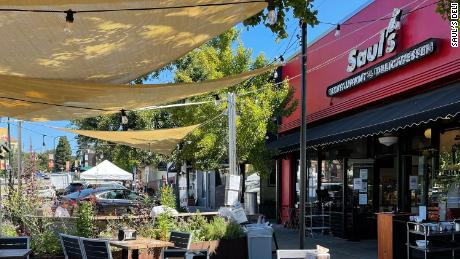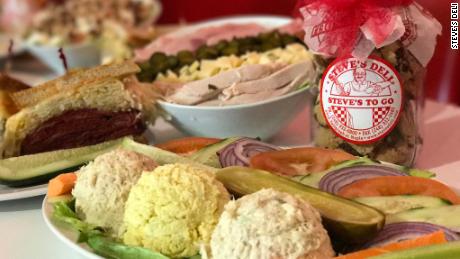For 28 years, Lederman co-owned the deli, where he would schmooze with customers, brine meats from scratch, make birthday “cakes” out of latkes and provide a space for all customers to feel welcome while serving up “edible culture.”
Then the coronavirus hit, and he was forced to close his deli for good — with no plans to reopen.
“When Covid came, actually we were getting busy. People needed food, everybody was closed,” Lederman said. “But with the curfews in New York City… and no business, lunch, catering, I’m doing an hour or two of business a night just for dinner. The store was killing me. We’re all taking turns getting sick from this virus.”
Lederman’s story is not uncommon. Many Jewish delis nationwide are shutting their doors as rents and the cost of ingredients increase, as people become more health-conscious, and as Jewish traditions are less frequently passed on to younger generations.
Gone are the days where city dwellers could find a pastrami sandwich and matzoh ball soup on almost every street corner. The schlep to get a tongue sandwich or stuffed derma is often tedious in some cities.
New York City — once home to more than 1,500 Jewish delis during the 1930s — is now home to just about 20, according to Ted Merwin, author of “Pastrami on Rye: An Overstuffed History of the Jewish Deli.” And that number is dwindling.
However, after a difficult last year-and-a-half, which led some delis to close indefinitely and others to shift to takeout, 14 deli owners CNN spoke to are optimistic. Wally Goetz, a third-generation owner of Lido Kosher Deli on Long Island, found that the pandemic brought in a new customer base that his deli hadn’t seen since the 1930s, which he describes as a “renaissance of young people.”
“They were home, they didn’t want to eat pizza every day, and all of a sudden, Lido Kosher Deli became an option that they never had,” Goetz said. “As horrible as it’s been, (the pandemic) was not a bad thing for our business, especially because we have an influx of new people.”
The rise and fall of the Jewish deli
The Jewish deli first appeared when Eastern European immigrants settled in the US in the late 19th century, primarily on the Lower East Side of Manhattan. Many delis were opened by the second generation of those immigrant families, Merwin said — possibly as an offshoot of Jewish-German gourmet food stores or converted kosher butcher shops.
Delis had not been part of Jewish culture prior to that, as most Jewish families rarely ate out, Merwin said.
“Jews didn’t have a lot of money, disposable income for buying food, they weren’t really able to trust that most of them were keeping kosher,” he said.
The numerical heyday of the deli, which began as a takeout spot before evolving into more of a sit-down eatery, was during the Great Depression, when there were an estimated 1,550 Kosher delis across the five boroughs, according to Merwin.
He described them as “cornerstones of the neighborhood” where Jews met their spouses, talked politics and developed strong cultural ties — even when they were becoming more secular.
“Jews needed the kosher deli as a really important communal gathering place,” he said. “I see the deli as on par with the synagogue during that era as a place for Jews to gather.”
After World War II, Jews began moving to Miami and Los Angeles, then to other areas of the country — and with them came the delis. The “New York-style deli” became popular throughout the country in the 1950s and 1960s, although some, like Shapiro’s Delicatessen in Indianapolis, had already long been open.
The number of delis began to decline during the 1950s with the rise of suburbanization, when Jews were not as closely packed together and did not regularly experience face-to-face interactions with each other.
“A lot of Jewish delis, a lot of Jewish food got stuck in time because it evolved in America, there was a dynamism in the early 20th century when all these immigrants were coming and bringing all sorts of new life, but eventually immigration stopped, and the food just kind of got standardized,” said Jeffrey Yoskowitz, a Jewish food expert who authored “The Gefilte Manifesto.”
“They didn’t adapt or evolve in any way, the way that they would have if people were still eating (at) them in Eastern Europe.”
This kind of “immigrant food” declined once immigration from Eastern Europe slowed after World War II, said David Sax, author of “Save the Deli: In Search of Perfect Pastrami, Crusty Rye, and the Heart of Jewish Delicatessen.”
The consolidation of delis into large neighborhood eateries threatened many smaller, independently owned delis, he said. “Did we need 20 delis and 20 butchers to serve every little corner, nook, and cranny of the block when we can get it all in one place?”
Despite a decline in numbers, Jewish delis have seen a revival around the turn of the 21st century, according to Sax. Recently opened delis are much more in tune with the values of sustainability, seeing success in California, Atlanta and Miami.
But these new spots serve a mostly non-Jewish clientele, in part because, according to Merwin, “the more cultural aspects of Judaism just haven’t really gotten transmitted down the generations.”
Jewish delis have faced new challenges in the pandemic
Dan Raskin and his ancestors have not changed much at Manny’s Cafeteria & Delicatessen in Chicago since it opened in 1942. Still serving up classic sandwiches, hot entrees and traditional seafood, the deli has cut just a few items and has expanded over the years. But when the pandemic hit, the 300-seat restaurant went from 1,000 customers a day to just 50.
Immediately after downtown Chicago became a ghost town, Raskin, the deli’s fourth-generation owner, pivoted to making long-distance deliveries to suburbs, working with a third party to deliver food nationally and reaching out to locals for support — which allowed the deli to hold on to staff and continue its 80-year-old traditions.
But rising food costs, and the challenges of finding passionate employees, have been burdensome, Raskin said. The margins in the deli business are particularly slim since people — many of whom are unfamiliar with the cuisine — cannot justify spending $15 to $20 on a sandwich.
“Our whole menu was created so there was basically zero waste from day to day, and it was a menu that was originally done to be able to provide nice portions to fill you up at a reasonable price. Unfortunately today, a lot of those cuts of meat and items are not the same thing, they became delicacies and more expensive,” he said.
Trisha Langer, who opened Daughter’s Deli in West Hollywood, California, in 2018, decided to create an “innovative” menu revolving around fresh ingredients while extending beyond just sandwiches and soups. Yet she found herself at a crossroads — deciding between raising prices on other items to absorb the high cost of pastrami, which costs nearly $10 per pound, or removing pastrami from the menu and losing customers.
“In this business, you’re not making money on things like pastrami, because the food cost is so incredibly high that you have to introduce other items like chicken to offset the cost,” Langer said.
This has allowed Saul’s to take a more flexible, seasonal approach to the menu, offering sustainable and locally sourced vegetarian and vegan options in addition to meats. California’s climate and the evolution of Jewish cooking has also led to a blending of Eastern European with Sephardic and Middle Eastern foods, reflected on Saul’s menu.
“There’s been a huge renaissance as more people started exploring both the history and the local resources that could enliven this cuisine, so that it was no longer a museum piece, strictly nostalgic but it was a living breathing cuisine again,” Adelman said.
Allan Domb, the owner of Schlesinger’s in Philadelphia, has tried to pull in younger clientele by adding more vegetarian and vegan items and adding new dishes every six months or so. Retaining the classic deli feel and the historic ambiance, though, was important for Domb, who noted that historically, delis represented “a sense of identity for people, the feeling of being at home.”
But there is hope for the future
Mile End Deli in Brooklyn is one of New York’s newest delis, established in 2010 to bring updated traditional Montreal-style deli cooking to newer audiences. The cooking processes are labor-intensive and painstaking, pulling from decades-old recipes for dishes like Bubbie’s brisket and chicken schnitzel.
But co-founder Joel Tietolman, who is nearing 40, is one of the youngest people to open a Jewish deli in the nation, and he, like Ari Weinzweig, co-founder of Zingerman’s Deli in Ann Arbor, Michigan, finds it important to keep traditions alive for younger generations who may have less connection to Judaism.
“Sometimes with tradition, a lot of moving forward is moving back,” said Weinzweig, whose restaurant offers traditional fare like kreplach and latkes as well as Cuban- and Italian-inspired options. “This goes back to milling our own grain, that’s just the way it would have been 150 years ago… making handmade cream cheese at the creamery, which is just how it all was a hundred-something years ago.”
In Atlanta, The General Muir takes a Southern approach to the traditional Jewish deli with fusion dishes like pastrami-braised collard greens.
Sam & Gertie’s in Chicago has converted overstuffed meat sandwiches into vegan ones using homemade “meats.”
And Kush by Stephen’s in Hialeah, Florida, — a creation by owner Matt Kuscher following the closing of long-time Jewish deli Stephen’s — has fused traditional elements of Jewish cooking with local Cuban influences, leading to creations like pastrami nachos and the Newman’s Jewban sandwich with pulled pork and corned beef.
“I knew that if I didn’t go and (keep the deli alive), this would be dead,” Kuscher said. “Even though I knew financially, it might not be the best business opportunity, I figured with my creativity I can swap it and turn it into something that everybody can find cool without taking away the integrity of the Jewish deli.”
Jewish delis also have been opening in areas of the country that have rarely seen Jewish culinary options. Others on the brink of closure have been resurrected or saved by younger generations.
Lester Schlan, who opened Max & Benny’s in Chicago, said he would have sold the business if it wasn’t for his son Benjamin, who helped navigate the 15,000-square-foot restaurant through the pandemic.
Evan Bloom, co-founder of San Francisco-based Wise Sons Jewish Delicatessen, is continuing to make accessible his family’s culinary traditions, even though the menu pulls from Korean and Latin American influences.
“There are some things that can change, ingredient sourcing can change. For a pastrami sandwich, honestly, nobody needs that much meat in the sandwich. But the flavors and smells, the roots of the taste, I think are really important to Jewish culture,” Bloom said.
At Steve’s Deli in Bloomfield Hills, Michigan, Alexandra Weitz runs the restaurant with her parents Stephen and Joanee Hurwitz. She chose to continue in her parents’ footsteps to continue traditions and to keep the deli — which they consider as a secular “synagogue” — alive for everyone in the community who has fond memories there.
“At the Jewish-style deli, you’re committed to continuing the tradition of family,” Weitz said.














